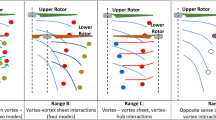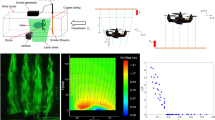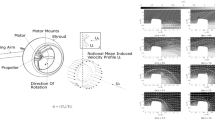Abstract
Ducted single and multi-rotor UAVs (unmanned aerial vehicle) offer better crash worthiness and safety compared to open rotor UAVs. The interactions that affect performance and acoustics are of interest. High speed stereo particle image velocimetry (SPIV), performance, and acoustic measurements were done on a rotor with removable protective duct to study rotor–duct aerodynamic interactions over a range of hover conditions at low Reynolds number. Instantaneous and averaged SPIV velocity field and performance results, as well as acoustic signatures, are compared to baseline un-ducted rotor cases. Increase in rotor figure of merit is strongly correlated with the level of duct interaction with rotor tip vortex cores. Efficiency change is higher for the cases where thrust induced losses take a larger share of the overall aerodynamic losses. While the overall acoustic sound pressure level was not affected significantly, cases with higher vortex core/duct interactions showed higher tonal content.
Graphical abstract










Similar content being viewed by others
References
Akturk A, Shavalikul A, Camci C (2008) PIV measurements and computational study of a 5-inch ducted fan for V/STOL UAV applications. In: 47th AIAA aerospace sciences meeting including the new horizons forum and aerospace exposition, p 332
Bohorquez F (2007) Rotor hover performance and system design of an efficient coaxial rotary wing micro air vehicle. Doctoral dissertation
Graftieaux L, Michard M, Grosjean N (2001) Combining PIV, POD and vortex identification algorithms for the study of unsteady turbulent swirling flows. Meas Sci Technol 12(9):1422. http://iopscience.iop.org/article/10.1088/0957-0233/12/9/307/pdf
Hein BR, Chopra I (2007) Hover performance of a micro air vehicle: rotors at low Reynolds number. J. Am. Helicopter Soc. 52(3):254–262
Heineck JT, Wadcock AJ, Yamauchi GK, Lourenco L, Abrego AI (2000) Application of three-component PIV to a hovering rotor wake. National Aeronautics and Space Administration Moffett Field CA AMES Research Center, California
Hrishikeshavan V (2011) Experimental investigation of shrouded rotor micro air vehicle in hover and in edgewise gusts, Doctoral dissertation
Kocurek JD, Tangler JL (1977) A prescribed wake lifting surface hover performance analysis. J. Am. Helicopter Soc. 22(1):24–35
Kunz P, Stawn R (2003) Analysis and design of rotors at ultra-low Reynolds numbers. In: 40th AIAA aerospace sciences meeting & exhibit, p 99
Lakshminarayan VK, Baeder JD (2010) Computational investigation of micro hovering rotor aerodynamics. J. Am. Helicopter Soc. 55(2):22001–22001
Landgrebe AJ (1971) An analytical and experimental investigation of helicopter rotor hover performance and wake geometry characteristics (no. K910828-31). United Aircraft Research Labs, East Hartford, CT
Martin P, Tung C (2004) Performance and flowfield measurements on a 10-inch ducted rotor VTOL UAV. Army Research Development and Engineering Command Moffett Field CA Aviation Aeroflight Dynamics Directorate
Pereira JL (2008) Hover and wind-tunnel testing of shrouded rotors for improved micro air vehicle design. Department of Aerospace Engineering, Maryland University College Park, College Park
Ramasamy M, Leishman JG, Lee TE (2007) Flowfield of a rotating-wing micro air vehicle. J. Aircr. 44(4):1236–1244
Ramasamy M, Johnson B, Leishman JG (2008) Understanding the aerodynamic efficiency of a hovering micro-rotor. J. Am. Helicopter Soc. 53(4):412–428
Rubio O, Gutiérrez F, Zuñiga JC, Funes-Gallanzi M (2013) Low-Re µUAV rotor design. In: Klapp J, Medina A, Cros A, Vargas CA (eds) Fluid dynamics in physics, engineering and environmental applications. Springer, Berlin, pp 489–500
Sciacchitano A, Neal DR, Smith BL, Warner SO, Vlachos PP, Wieneke B, Scarano F (2015) Collaborative framework for PIV uncertainty quantification: comparative assessment of methods. Meas Sci Technol 26(7):074004
Shukla D, Hiremath N, Patel S, Komerath N (2017) Aerodynamic interactions study on low-Re coaxial and quad-rotor configurations. In: ASME 2017 international mechanical engineering congress and exposition. American Society of Mechanical Engineers, pp V007T09A023–V007T09A023
Shukla D, Hiremath N, Komerath NM (2018) Low Reynolds number aerodynamics study on coaxial and quad-rotor. In: Applied aerodynamics conference, AIAA aviation and aeronautics forum and exposition 2018, p 4118
Acknowledgements
This research was partially funded by the Government Vertical Lift Rotorcraft Centers of Excellence, under Agreement no. W911W6-17-2-0002. The U.S. Government is authorized to reproduce and distribute reprints for Government purposes notwithstanding any copyright notation thereon. The U.S. Government technical monitor is Mahendra Bhagwat. The views and conclusions contained in this document are those of the authors and should not be interpreted as representing the official policies, either expressed or implied, of the Aviation Development Directorate or the U.S. Government. We would also like to thank Dr. Nandeesh Hiremath for his help in acoustic tests and the team of undergraduate researchers in the Experimental Aerodynamics lab at Georgia Tech for their assistance in building the setup and tests.
Author information
Authors and Affiliations
Corresponding author
Additional information
Publisher’s Note
Springer Nature remains neutral with regard to jurisdictional claims in published maps and institutional affiliations.
Rights and permissions
About this article
Cite this article
Shukla, D., Komerath, N. Rotor–duct aerodynamic and acoustic interactions at low Reynolds number. Exp Fluids 60, 20 (2019). https://doi.org/10.1007/s00348-018-2668-z
Received:
Revised:
Accepted:
Published:
DOI: https://doi.org/10.1007/s00348-018-2668-z




